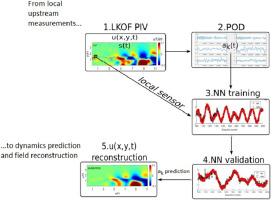当前位置:
X-MOL 学术
›
Int. J. Heat Fluid Flow
›
论文详情
Our official English website, www.x-mol.net, welcomes your
feedback! (Note: you will need to create a separate account there.)
Prediction of the dynamics of a backward-facing step flow using focused time-delay neural networks and particle image velocimetry data-sets
International Journal of Heat and Fluid Flow ( IF 2.6 ) Pub Date : 2020-04-01 , DOI: 10.1016/j.ijheatfluidflow.2019.108533 Antonios Giannopoulos , Jean-Luc Aider
International Journal of Heat and Fluid Flow ( IF 2.6 ) Pub Date : 2020-04-01 , DOI: 10.1016/j.ijheatfluidflow.2019.108533 Antonios Giannopoulos , Jean-Luc Aider

|
Abstract The objective of this experimental work was to evaluate the potential of an artificial Neural Network (NN) to predict the full-field dynamics of a standard separated, noise-amplifier flow: the Backward-Facing Step (BFS) flow at R e h = 1385 . Different upstream local visual sensors, based on the velocity fields measured by time-resolved Particle Image Velocimetry, were tested as inputs for the Neural Network. The dynamic coefficients of a Proper Orthogonal Decomposition (POD) were defined as goals-outputs for this non-linear mapping. The coefficients time-series were predicted and the instantaneous velocity fields were reconstructed with satisfying accuracy with a Focused Time-Delay Neural Network (FTDNN). Using a time-delay appears like a crucial choice to ensure an accurate prediction of the dynamics of the BFS flow. A shallow FDTNN is sufficient to obtain good accuracy with low computational time. The influence of the choices of inputs-sensors, the size of the training data-set, the number of neurons in the hidden layer as well as the sensor delay on the accuracy of the predicted flow are discussed for this experimental fluid system.
中文翻译:

使用聚焦时延神经网络和粒子图像测速数据集预测后向阶梯流的动力学
摘要 本实验工作的目的是评估人工神经网络 (NN) 预测标准分离噪声放大器流的全场动力学的潜力:R eh = 处的后向步 (BFS) 流1385。基于时间分辨粒子图像测速法测量的速度场,不同的上游本地视觉传感器作为神经网络的输入进行了测试。适当正交分解 (POD) 的动态系数被定义为该非线性映射的目标-输出。系数时间序列被预测,瞬时速度场用聚焦时延神经网络(FTDNN)以令人满意的精度重建。使用时间延迟似乎是确保准确预测 BFS 流动态的关键选择。浅层 FDTNN 足以以较低的计算时间获得良好的精度。该实验流体系统讨论了输入传感器的选择、训练数据集的大小、隐藏层中的神经元数量以及传感器延迟对预测流量精度的影响。
更新日期:2020-04-01
中文翻译:

使用聚焦时延神经网络和粒子图像测速数据集预测后向阶梯流的动力学
摘要 本实验工作的目的是评估人工神经网络 (NN) 预测标准分离噪声放大器流的全场动力学的潜力:R eh = 处的后向步 (BFS) 流1385。基于时间分辨粒子图像测速法测量的速度场,不同的上游本地视觉传感器作为神经网络的输入进行了测试。适当正交分解 (POD) 的动态系数被定义为该非线性映射的目标-输出。系数时间序列被预测,瞬时速度场用聚焦时延神经网络(FTDNN)以令人满意的精度重建。使用时间延迟似乎是确保准确预测 BFS 流动态的关键选择。浅层 FDTNN 足以以较低的计算时间获得良好的精度。该实验流体系统讨论了输入传感器的选择、训练数据集的大小、隐藏层中的神经元数量以及传感器延迟对预测流量精度的影响。










































 京公网安备 11010802027423号
京公网安备 11010802027423号